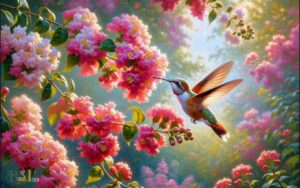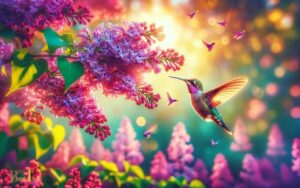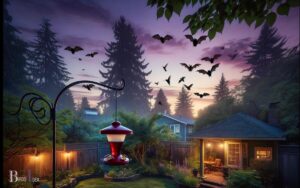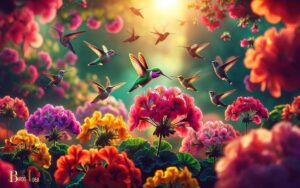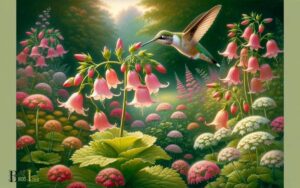Do Vinca Flowers Attract Hummingbirds? Yes!
Yes, vinca flowers can attract hummingbirds due to their nectar-rich blooms. However, they are not as attractive to hummingbirds as other flowers with more prominent tubular shapes.
Vinca flowers, also known as periwinkles, can be a food source for hummingbirds, especially in landscapes where more preferable flowers are scarce.
Hummingbirds are primarily attracted to brightly colored, tubular flowers that provide an abundance of nectar, such as fuchsias, bee balms, and salvia.
While vincas do produce nectar and can come in shades of red which hummingbirds are drawn to, their flower structure is not as ideally shaped for hummingbird feeding as those with longer floral tubes.
Additionally, vincas typically have smaller flowers, which may not be as easily accessible to hummingbirds as larger blooms would be.
While vinca flowers may not be the top pick for hummingbirds, they can still contribute to a garden that supports a variety of wildlife, including these tiny, fast-flying birds.
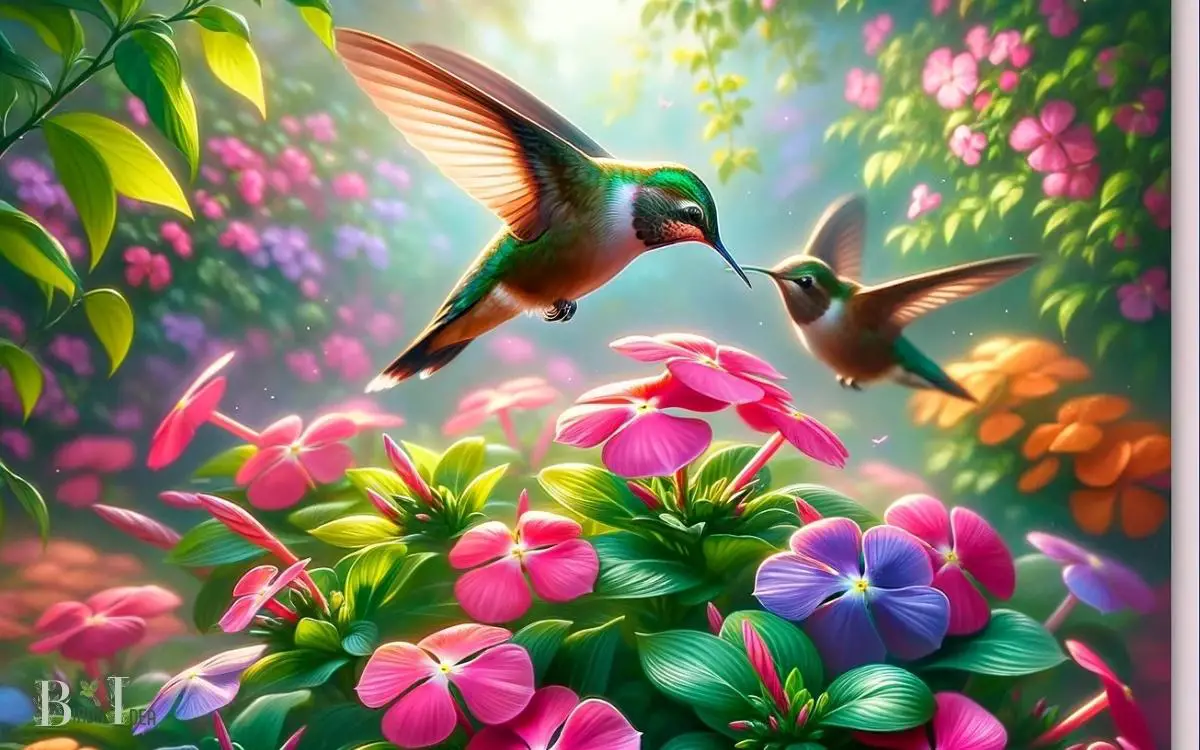
Key Takeaway
Characteristics of Vinca Flowers
Vinca flowers are known for their five-petaled blooms and glossy, evergreen leaves. These flowers, also called periwinkles, come in various shades of pink, purple, and white, adding a pop of color to gardens and landscapes.
Vinca plants are low-growing and spread quickly, making them popular ground cover options. They thrive in well-drained soil and prefer full sun but can also tolerate partial shade.
Vinca flowers are drought-tolerant once established and require minimal maintenance, making them a favorite among gardeners.
Their ability to bloom throughout the summer and into the fall makes them a valuable addition to any garden.
With their attractive appearance and ease of care, vinca flowers are a delightful choice for both experienced and novice gardeners.
Hummingbird Feeding Habits
Hummingbirds are known for their unique feeding habits, particularly their reliance on nectar sources to fuel their high-energy lifestyle.
Understanding their feeding behavior and foraging techniques can provide valuable insight into how they interact with different flower species, such as vinca flowers.
Additionally, the characteristics of flowers and the availability of nectar play a significant role in attracting and sustaining hummingbird populations in specific areas.
Hummingbirds and Nectar Sources
Hummingbirds actively seek out nectar sources that provide the high energy levels they require for maintaining their rapid metabolism.
To satisfy their feeding habits, they seek the following:
- Abundance: Hummingbirds are attracted to areas with a high concentration of nectar-producing flowers or feeders.
- High Sugar Content: They prefer nectar with a sugar content ranging from 20-25% to meet their energy needs.
- Color and Scent: Brightly colored and fragrant flowers are more likely to attract hummingbirds.
- Shape of Flowers: Hummingbirds have long bills and can access nectar from tubular or trumpet-shaped flowers.
Understanding these preferences can help in creating a suitable environment to attract and support hummingbirds in their search for nectar sources.
Feeding Behavior and Foraging
With a need for high energy levels, hummingbirds continue to actively seek out nectar sources that meet their feeding preferences, including abundance, high sugar content, color, scent, and specific flower shapes.
Hummingbirds have remarkable feeding habits. They are known for their hovering and darting flight patterns, which allow them to visit a large number of flowers in a short amount of time.
Their long, specialized bills and extendable, tube-like tongues enable them to reach deep into flowers to access nectar.
Below is a table summarizing some intriguing hummingbird feeding behaviors:
| Feeding Behavior | Description |
|---|---|
| Hovering | Ability to maintain position while sipping nectar |
| Traplining | Regular route of visiting specific nectar sources |
| Dip-feeding | Touching the nectar with their open bill and tongue |
| Territoriality | Defending a particular food source |
| Helicopter Flight | Ability to move in any direction, including backward |
Understanding these characteristics sheds light on why Vinca flowers are attractive to hummingbirds, making them an excellent addition to a hummingbird-friendly garden.
Flower Color and Hummingbird Attraction
One would expect that certain flower colors may be more attractive to hummingbirds due to their keen perception of color.
Hummingbirds are drawn to bright, vivid hues like red, orange, and pink, as these colors signal potential nectar sources.
They have a particular affinity for red, as it stands out against the green foliage and is often associated with high-energy nectar.
While red is a primary attractant, hummingbirds also show interest in other vibrant colors such as orange and pink.
It’s important to note that while these colors are preferred, hummingbirds will still visit flowers of other colors if they contain ample nectar.
Understanding the relationship between flower color and hummingbird attraction can aid in creating a garden that is more appealing to these delightful birds.
Nectar Production in Vinca Flowers
Hummingbirds are attracted to vinca flowers due to the nectar produced within their blooms. The nectar production in vinca flowers is an essential factor that draws hummingbirds to these plants.
Here are a few key points about nectar production in vinca flowers:
- Nectar Composition: Vinca flowers produce nectar with a high sucrose concentration, which is a preferred energy source for hummingbirds.
- Nectar Accessibility: The nectar in vinca flowers is easily accessible due to the tubular shape of the blooms, allowing hummingbirds to feed efficiently.
- Nectar Refilling: Vinca flowers have the ability to refill their nectar reserves relatively quickly, providing a reliable food source for visiting hummingbirds.
- Nectar Quantity: Despite their small size, vinca flowers can produce a sufficient quantity of nectar to sustain hummingbird visits.
The nectar production in vinca flowers plays a significant role in attracting and supporting hummingbirds.
Other Factors Influencing Hummingbird Attraction
Among the various factors influencing hummingbird attraction, some nectar-producing flowers offer a diverse array of colors and shapes that can also play a significant role in attracting these agile birds.
Hummingbirds are attracted to a wide range of flower colors, particularly red, orange, and pink, as these colors are easily visible to them.
The shape of the flower also matters, as hummingbirds have long beaks and tongues, allowing them to reach nectar from deep tubular flowers.
Additionally, the abundance of flowers and their arrangement within a garden can impact hummingbird attraction.
Providing a variety of flowers that bloom at different times throughout the season ensures a consistent nectar source for these birds.
Understanding these factors can help in creating a garden that is more appealing to hummingbirds.
Tips for Attracting Hummingbirds to Your Garden
Want to attract hummingbirds to your garden? Consider planting flowers in vibrant colors like red, orange, and pink, as these are known to catch the attention of these tiny birds.
Additionally, using hummingbird feeders with a nectar solution can provide a supplemental food source, making your garden even more inviting to these delightful creatures.
Flower Color Selection
When selecting flower colors to attract hummingbirds to your garden, it is important to consider the hues that are most appealing to these tiny birds.
Here are some tips for choosing the right flower colors to attract hummingbirds:
- Bright Reds: Hummingbirds are naturally attracted to bright red flowers, as this color is easily visible to them from a distance.
- Orange Hues: Flowers in shades of orange are also attractive to hummingbirds and can help to draw them to your garden.
- Pink and Coral: These softer hues are also appealing to hummingbirds and can complement the brighter red and orange flowers in your garden.
- Avoid White: While white flowers can be beautiful, they are less likely to catch the attention of hummingbirds, so it’s best to focus on the more vibrant colors.
Use Hummingbird Feeders
Hummingbirds are attracted to gardens with a plentiful supply of nectar, which can be easily provided by using hummingbird feeders.
To attract these delightful creatures to your garden, consider the following tips for using hummingbird feeders:
- Location: Place feeders in partially shaded areas to prevent nectar from spoiling too quickly.
- Cleaning: Regularly clean feeders with a solution of hot water and vinegar to prevent mold and bacteria growth.
- Refill: Keep feeders filled with fresh nectar, especially during peak migration seasons.
- Variety: Use multiple feeders to accommodate territorial behavior and attract more hummingbirds.
Importance of Maintenance and Care
Proper maintenance and care of Vinca flowers can significantly impact their ability to attract hummingbirds.
To ensure the best chance of attracting these beautiful birds, individuals should follow these maintenance and care tips:
- Regular Watering: Vinca flowers thrive in well-drained soil but require consistent watering, especially during hot and dry periods.
- Pruning and Deadheading: Regularly remove spent blooms and trim back leggy growth to encourage continuous blooming and a tidy appearance.
- Fertilization: Apply a balanced fertilizer to Vinca flowers every few weeks to promote healthy growth and abundant blooms.
- Pest Control: Keep an eye out for common pests like aphids or spider mites and take appropriate measures to keep the plants healthy and pest-free.
Conclusion
While vinca flowers are not typically known for attracting hummingbirds, their bright colors and nectar production may still catch the attention of these tiny birds.
To increase the chances of attracting hummingbirds to your garden, consider planting other nectar-rich flowers and providing a clean and accessible source of water.
With the right combination of flowers and care, you may just be able to create a hummingbird-friendly environment in your own backyard.

